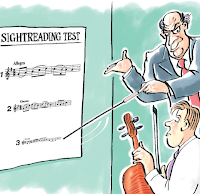When I'm teaching, no matter what the ability of the student, the same technical basics continually crop up. Their priniples are the same, whether employed by a beginner or an advanced student. An example is the bow distribution, the stretch of bow to be used in a particular musical circumstance. The ability to use an appropriate length of bow stroke and vary its weight and position between the bridge and fingerboard, requires development from the word go and that development continues throughout the violinist's lifetime.
Other such basics are the bow hold, the left-hand shape, tuning, playing in time, playing at the required tempo, the development of sight reading, the ability to be expressive with dynamics, vibrato, tone colour and variation of tempo. All of these and more are relevant to the beginner and the advanced student alike.
So, I have begun to produce a series of short video podcasts, each on an individual topic and each of relevance to all students of the violin. The series is called 'Violin Fundamentals for All'. I've designed these presentations to be of relevance to all students as the principles in each topic are always the same no matter what the student's level of ability. The aim is that the violin student will be able to choose a particular skill and learn 'how to improve it' from the advice and demonstrations that I present.
Find my Youtube channel and hit the subscribe button for notifications of when each video is published.









